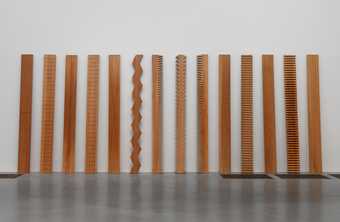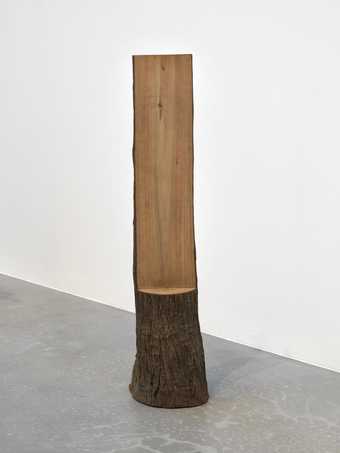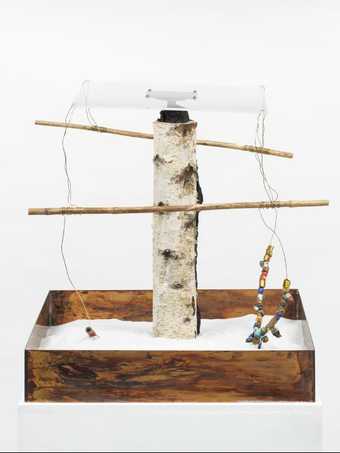This seminar examines two international ‘contact points’ between artists in the twentieth century: the 1970 Tokyo Biennale and David Medalla’s performance practice in London and the Philippines.
Contact Points represents the culmination of Tate Research Centre: Asia’s Visiting Fellowship Programme in 2016; both Eva Bentcheva and Yohko Watanabe conducted their research as the Centre’s Visiting Fellows.
Panel One: 14.00–15.45
A Stitch in Time? Situating David Medalla’s ‘Participation-Performance’ between British and Philippine Performance Art History
Chair: Eva Bentcheva
Speakers: David Medalla and Adam Nankervis
Since the 1950s, Philippine-born artist David Medalla has traversed avant-garde artistic circles in Britain, France, the USA and the Philippines. Alongside developing a rich practice comprising performance, sculpture, painting and poetry, Medalla frequently acted as a ‘contact point’ for artists from a range of nationalities and backgrounds. In particular, his initiation of numerous groups and organisations stands testament to the importance of communication, exchange and contact-making in his artistic philosophy.
This panel explores how Medalla served as a ‘contact point’ between different artists, as well as discourses around socialism and human rights, and the arts in Britain and the Philippines during the late 1960s and early 1970s. It focuses on his ‘participation-production performances’, tracing how he employed collective action as a means to foster dialogues, new encounters and collective reflection in his audiences.
Break: 15.45–16.15
Panel Two: 16.15–18.00
Tokyo Biennale 1970 as Contact Point
Chair: Yohko Watanabe
Speakers: Toshiaki Minemura and Susumu Koshimizu
The 1970 Tokyo Biennale, titled Between Man and Matter, was held at Tokyo Metropolitan Museum in May 1970. After undertaking an extensive research trip in Europe and the United States, the commissioner/curator Yusuke Nakahara commissioned 27 international artists – seventeen of whom came to Japan for the installation – to present their work alongside 13 Japanese artists.
This panel will meditate on the legacy of this iconic exhibition, presenting it as an important moment of cultural exchange – or ‘contact point’ – between the participating Japanese and western artists. The panel is chaired by Yohko Watanabe, Tate Research Centre: Asia Visiting Fellow and the speakers include Susumu Koshimizu – one of the youngest Japanese artists to participate in Tokyo Biennale 1970 – and Nakahara’s collaborator Toshiaki Minemura.
Biographies
Susumu Koshimizu
Susumu Koshimizu (b.1944, Uwajima, Ehime) is a sculpture and installation artist based in Osaka. Koshimizu was a key member of Mono-ha (‘School of Things’): the Japanese artistic movement that privileged ‘non-making’ by displaying raw and often industrial materials with minimal intervention. For the 1970 Tokyo Biennale, Koshimizu produced two works – Iron Plate I and Iron Plate II – and was one of the youngest artists that participated. In addition to solo exhibitions in Japan and the United States, Koshimizu’s work has featured in several notable international surveys including Avant-Garde Art of Japan 1910–1970 (Centre Georges Pompidou, Paris 1986); Japanese Art After 1945: Scream Against the Sky (Solomon R. Guggenheim Museum, New York 1994) and most recently Mono-ha(Fonazione, Milan 2015). From 1980–2010, Koshimizu taught in the sculpture department at Kyoto City University of Art, and served as a president of Takarazuka
David Medalla
David Medalla (b.1942, Manila) is a pioneer of kinetic art, participatory art and performance art. After moving to New York aged 12 to study at Columbia University, Medalla returned to Manila in the late 1950s where he met the earliest patrons of his art. In 1960, French philosopher Gaston Bachelard introduced Medalla’s performance in homage to Rimbaud at the Academy of the Arts of Raymond Duncan in Paris; two decades later, Louis Aragon introduced another performance by Medalla at Galerie Biren, and Marcel Duchamp honoured him with a ‘medallic’ object. Medalla was included in Harald Szeemann’s Weiss auf Weiss (Kunsthalle Bern, 1966) and Live in Your Head: When Attitudes Become Form (Kunsthalle Bern, 1969) and in the DOCUMENTA 5 exhibition in 1972 in Kassel. In London, Medalla edited the journal SIGNALS, (1964–1966), initiated the international multi-media artist collective the Exploding Galaxy in 1967, and from 1974–1977 was the chairman of Artists for Democracy. David Medalla co-founded the Mondrian Fan Club with Adam Nankervis in 1991 and the London Biennale in 1999.
Toshiaki Minemura
Toshiaki Minemura (b. 1936, Nagano) is an art critic based in Japan. A graduate of French literature at the University of Tokyo, Minemura’s writings cover a range of subjects including notable contributions on the Mono-ha movement, and on modern and contemporary sculpture and painting. As a curator, Minemura contributed to the Tokyo Biennale 1970, the Biennale de Paris in 1971, 1973 and 1975, the Biennale Internacionale de Artes de São Paulo in 1977 and 1981 and the twenty-part exhibition series Exhibition of ‘Parallelism in Art’ (1981–2005). Minemura taught at Tama Art University in Tokyo from 1979 to 2005, and has been director of Tama Art University Museum since 2006. He became a member of the International Association of Art Critics (AICA) in 1970’s, and has served as the president of AICA Japan Region since 2012.
Adam Nankervis
Adam Nankervis (b.1965) is an artist and curator who has infused social, conceptual and experimental practice in his lived-in nomadic museum, ‘Museum MAN’, and his ongoing project ‘another vacant space’. His immersion into the experimentation of social sculptural forms and aesthetic collisions are a trademark of his art. His curatorial practice is infused within his own projects: Blurprint of The Senses (Liverpool Biennale, 2006); A Spires Embers (Arsenal Kiev 2009); iIsolation (Izolyatsia Donetsk, Ukraine 2010); A Wake (Dumbo Arts Center, New York 2012). Nankervis’ work also featured in the 1997 Johannesburg Biennale, LIFE/LIVE (Musée d’Art Moderne de la Ville de Paris 1966) and the 2001 Los Angeles Biennale. In collaboration with David Medalla, Nankervis formed The Mondrian Fan Club in 1991, and is the International Coordinator of the London Biennale 2000–2016 which was founded as a free-form artist initiative. Nankervis manages Medalla’s archive in Berlin.
Tate Research Centre: Asia has been established with generous support from the Andrew W. Mellon Foundation. In association with the Japan Foundation who provided Japanese translation.



